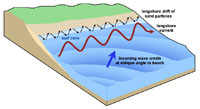12.10: Longshore Currents and Longshore Drift
- Page ID
- 10341
Longshore Currents and Longshore Drift
A longshore current is a current that flows parallel to the shore within the zone of breaking waves. Longshore currents develop when waves approach a beach at an angle (Figure 12.37). Longshore currents cause sediment transport called longshore drift. Longshore drift is the movement of sediments along a coast by waves that approach at an angle to the shore but then the swash recedes directly away from it. The water in a longshore current flows up onto the beach, and then back into the ocean in a “sheet-like” formation. As this sheet of water moves on and off the beach, it can transport beach sediment back out to sea. Objects floating in the longshore current move in a zigzag pattern up and down the beach as it moves down current.

Figure 12.37. Longshore currents and longshore drift are caused by waves approaching the beach at an oblique angle.


